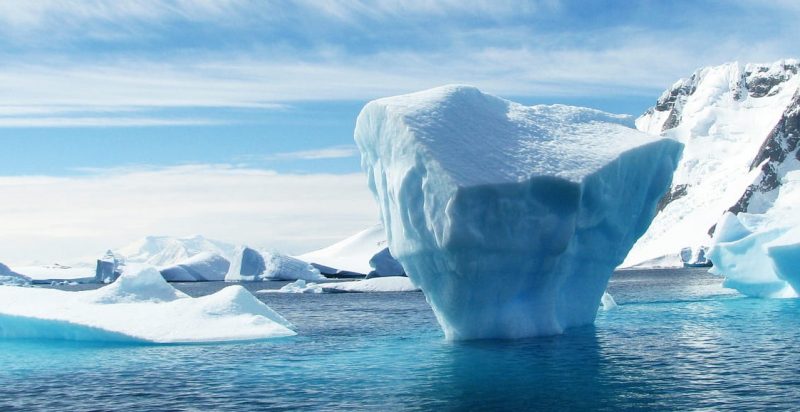We explore the Arctic Ocean, and discuss its location and extent. In addition, we describe its characteristics, ocean currents, and more.

What is the Arctic Ocean?
The Arctic Ocean is the world’s smallest and northernmost body of water. It lies within the Arctic Circle, and is bounded by the coasts of North America, Asia, and Europe. It is the coldest ocean on Earth, with its waters being covered by thick sea ice for most of the year.
It spans an area of about 5.4 million square miles (14 million km2), and has an average depth of 3,953 feet (1,205 m) below sea level. Its deepest point is found in the Makarov Basin, reaching 14,764 feet (4,500 m) below sea level.
Despite the prevailing extreme cold and darkness throughout much of the year, the Arctic Ocean is home to a wide biodiversity, with species such as polar bears, seals, and whales adapted to the icy environment.
The Arctic Ocean is particularly vulnerable to climate change, warming faster than other parts of the world. This has led to a decline in sea ice extent, rising water temperature, and ocean acidification, which negatively impact marine life.
In recent years, the Arctic Ocean has emerged as a region with growing geopolitical significance due to the natural resources it harbors and the shipping routes that are opening up as sea ice shrinks as a result of climate change.
The salinity of the Arctic Ocean is the lowest of all the Earth’s oceans, due to low evaporation and freshwater inflows from melting ice.
- See also: North Pole
Arctic Ocean facts
The main characteristics of the Arctic Ocean are:
- It is the world’s smallest ocean, covering an area of about 5.4 million square miles (14 million km2).
- It began to form 200 million years ago with the breakup of Pangea.
- Its flora and fauna are adapted to ice and low temperatures.
- It contains significant oil and natural gas reserves
How was the Arctic Ocean formed?
The Arctic Ocean spread and expanded as the continents began to drift apart following the breakup of Pangea. Two hundred million years ago, when this single supercontinent existed, the Arctic Ocean was smaller than it is today. Continental drift and the formation of new oceanic crust caused the Arctic to gradually increase its extent.
In addition, in Pangea’s time, the Arctic Ocean lay at lower latitudes, where the climate was warmer than at present. Over geologic time, the Arctic Ocean spread towards increasingly colder regions, causing its water temperature to plummet.
Arctic Ocean climate

The Arctic Ocean has a polar climate, with extremely low temperatures throughout much of the year. In winter, the low temperature reaches -22 °F (-30 °C). The long winters typically cause vast expanses of sea ice to form. Sea ice plays a crucial role in the region's ecosystem, marine life, and global climate dynamics.
In the summer, the high temperature can reach 50 °F (10°C). During this time of year, sea ice partially melts, allowing navigation in previously frozen areas.
The sea-ice surface of the Arctic is covered by ice caps that double in size during the winter and are surrounded by frozen water in summer. Beneath the ice, the waters remain frozen.
Flora and fauna of the Arctic Ocean

The Arctic is inhabited by animal species adapted to the intense cold, such as seals, sea lions, various whale species, and polar bears, the Arctic’s top predators. Krill also abounds, a small crustacean that plays a vital role at the base of the marine ecological pyramid. Other frequent species include cod, salmon and herring, which are heavily exploited by fisheries in neighboring countries.
The animal species inhabiting the region have evolved adaptations that enable them to thrive in the Arctic’s extreme climate. Abundant fur, thick layers of fat, and thick skin allow them to keep warm, while white coloration helps them camouflage in the ice.
Vegetation in the Arctic is sparse, consisting mainly of mosses, lichens, and phytoplankton.
Natural resources of the Arctic Ocean

The Arctic Ocean holds significant oil and natural gas reserves on its continental shelves. Countries like Russia, Norway, Canada, Denmark, and the United States have interests in the extraction of these resources, with oil companies from these countries extracting oil and natural gas from its waters.
Likewise, the Arctic Ocean contains a diversity of valuable minerals like gold, silver, zinc, and nickel. Mineral exploitation is carried out by neighboring countries, particularly Russia, a major producer and exporter of these resources.
In addition, the Arctic Ocean is highly valued for its fishery. Species populating Arctic waters include cod, salmon, and herring. Countries such as Norway, Russia, Iceland and Canada are the world's leading producers and exporters of these species.
Pollution in the Arctic Ocean

Oil drilling on the Arctic continental shelf has led to severe water pollution. Oil spills and the release of chemical pollutants from oil activities have impacted marine biodiversity and altered the chemical composition of the water. This has increasingly devastating effects on fishery, which accounts for a substantial part of the income of the countries in the region.
Moreover, climate change causes the Arctic water temperature to rise. The melting of polar ice caps on the ocean waters impacts marine life, especially those animals that depend on sea ice for survival. Rising temperatures also alter the migration patterns and behavior of marine fauna, impacting their development and reproduction.
Explore next:
References
- Iniseg. (2020). El Ártico: guerra geopolítica por recursos de petróleo y gas. https://www.iniseg.es/
- National Geographic. (2010). Océanos. https://www.nationalgeographic.es/
- Portillo, G. (2023). Qué son y cómo se forman las corrientes marinas. Meteorología en Red. https://www.meteorologiaenred.com/
- Universidad Complutense de Madrid. (s.f.). El Ártico, el punto más caliente del cambio climático. ucm.es/data/cont/docs/
Was this information useful to you?
Yes NoThank you for visiting us :)